new orleans

 My niece, Lacey Killinger has had a banner year this year. Most of this past year was spent planning for and preparing for her wedding. There were fittings, parties, a bachelorette trip to Nashville, all culminating in the wedding of her dreams on October 28, 2023. On that day, Lacey became not only a wife to Chris, but a bonus mom to her beautiful bonus kids, Brooklyn and Jaxon. Lacey truly loves those two kids. She has a kind heart and a sweet spirit, and the kids really love her for it. It was such a beautiful day, and it was so special to see her dreams come true. They immediately turned into a completed family, even though they were pretty much a family before…from the very beginning to be exact.
My niece, Lacey Killinger has had a banner year this year. Most of this past year was spent planning for and preparing for her wedding. There were fittings, parties, a bachelorette trip to Nashville, all culminating in the wedding of her dreams on October 28, 2023. On that day, Lacey became not only a wife to Chris, but a bonus mom to her beautiful bonus kids, Brooklyn and Jaxon. Lacey truly loves those two kids. She has a kind heart and a sweet spirit, and the kids really love her for it. It was such a beautiful day, and it was so special to see her dreams come true. They immediately turned into a completed family, even though they were pretty much a family before…from the very beginning to be exact. 
Over the past few years, many things in Lacey’s life have been taking an upward turn. It’s not that she was in a slump, because she wasn’t, but rather, it’s because she is receiving so many blessings from God in her life. The Bible talks about overflowing abundance and joy, and that is exactly what is going on in Lacey’s life right now. She owns her own hair salon, called LuxLou Beauty, and she specializes in hair and makeup for weddings. Business is going so well for her, that she is often booked out for months in advance. there is no better to gauge the success of a business than how busy they are.
Lacey and Chris are just perfect for each other. They are of like temperament, and they like many of the same 
 things. They are loving parents to the children, and the kids love them both so much. Their workplaces are much different, but that is to be expected, and both are exerts in their field, so they are successful at their jobs. They are both soft-spoken, and very loving people. Anyone who knows them is blessed by them. They always look forward to summer, as they love to got to the lake and hang out with the family The kids especially love going to the lake to cool off and swim. Family time is very important to the Stevens family (Lacey’s family) as a whole, and they really love to get together for various summertime gatherings, like an annual family reunion. Chris and the kids totally love going and everyone has a great time. Today is Lacey’s birthday. Happy birthday Lacey!! Have a great day!! We love you!!
things. They are loving parents to the children, and the kids love them both so much. Their workplaces are much different, but that is to be expected, and both are exerts in their field, so they are successful at their jobs. They are both soft-spoken, and very loving people. Anyone who knows them is blessed by them. They always look forward to summer, as they love to got to the lake and hang out with the family The kids especially love going to the lake to cool off and swim. Family time is very important to the Stevens family (Lacey’s family) as a whole, and they really love to get together for various summertime gatherings, like an annual family reunion. Chris and the kids totally love going and everyone has a great time. Today is Lacey’s birthday. Happy birthday Lacey!! Have a great day!! We love you!!
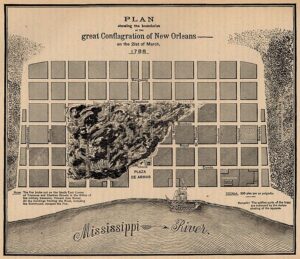
 I don’t know what kind of a city New Orleans was in 1788, but much of it changed that year, because on March 21, 1788, the first of two great fires left the city in ruins. There are a number of ways to destroy a city…time, storms, neglect, need, and the worst one, fire. Were it not for two great fires, there might be more of colonial New Orleans left for people to enjoy. Unfortunately, two great fires in the late eighteenth century left New Orleans and its inhabitants very few years to re-establish their institutions before the onset of American domination in 1803, making the city more American than French. Today, there are several fine houses that date to the last colonial decade, as well as the French Quarter, including the Cabildo and the Presbytere, but they are “post-fire” nevertheless.
I don’t know what kind of a city New Orleans was in 1788, but much of it changed that year, because on March 21, 1788, the first of two great fires left the city in ruins. There are a number of ways to destroy a city…time, storms, neglect, need, and the worst one, fire. Were it not for two great fires, there might be more of colonial New Orleans left for people to enjoy. Unfortunately, two great fires in the late eighteenth century left New Orleans and its inhabitants very few years to re-establish their institutions before the onset of American domination in 1803, making the city more American than French. Today, there are several fine houses that date to the last colonial decade, as well as the French Quarter, including the Cabildo and the Presbytere, but they are “post-fire” nevertheless.
The French Quarter of today is very different from what it once was, and it makes me wonder what it might have been like before. These days, the French Quarter receives millions of visitors annually, and it’s hard to imagine the carnage of the fire of Holy Saturday morning in 1788. The fire was devastating, with smoking ruins stretching from Chartres to Dauphine Street, and from Conti to Saint Philip. The fire actually began on Good Friday morning in the home of Spanish treasurer Don Vincente Nunez at Toulouse and Chartres. The wind was blowing out of the southeast bringing in a blustery cold front. The wind, combined with the fire, reduced over eight hundred homes and public buildings to ashes in a matter of hours. The church, the town hall, and the rectory on the Plaza de Armas were suddenly gone. Governor Esteban Miro told Spanish authorities of the “abject misery, crying, and sobbing” of the people. He wrote that the faces of the families, “told the ruin of a city which in less than five hours has been transformed into an arid and horrible wilderness; the work of seventy years since its foundation.”
The rebuilding of the city began right away, but had barely started when, in 1794 a second fire and two hurricanes swept the city. It seemed that New Orleans was doomed to devastation. The December 8, 1794, fire burned 212 buildings…fewer than the prior fire, but these buildings were more valuable. After the two storms and both fires were done, nearly all the public buildings, homes and businesses, except those fronting the river had been reduced to ashes or badly damaged. Through it all the Ursuline nuns in their convent on Chartres Street had prayed over their hometown, and as the fire got close to the convent on that Good Friday, the wind suddenly shifted. Miraculously, the convent survived and still stands today.
The French Quarter was essentially changed forever. “Baked tile and quarried slate replaced the roofs of ax-hewn cypress shingles. Buildings, set at the sidewalk or banquette, were of all brick, with common firewalls. The wide and shallow hipped roof, galleried townhouse perfected in the French period gave way to vertical, long and narrow Spanish-style town homes, many with overhangs, iron work and entresols or mezzanines. The Cabildo and Presbytere came into being. A new church rose from the ashes. A suburb opened on the upper side of town for residents wary of crowded Quarter conditions. Fire pumps were commissioned. The market moved riverside. Artisans were called in. Protestants gained a foothold. But people went homeless, the city indebted, and lives were lost to death or removal. The city was different.”
Since 1794, the French Quarter has been spared large fires, although there have been some smaller fires, and the hurricanes kept coming. They are just common to the area. A great storm that took place on August 19, 1812, swept away a one-year-old French Market building. Another in 1915 damaged the steeple of Saint Louis Cathedral. A fire in September 1816 took the popular Orleans Theater and Orleans Ballroom. Then, the rebuilt theater burned again in 1866. Fire damaged the Bank of Louisiana on Royal Street resulting in the monumental columns installed in the remodeling, which is now the home of the Vieux Carré Commission.
These devastating losses have resulted in a stringent French Quarter fire code. No longer is the Mardi Gras 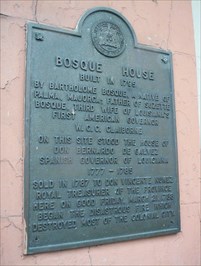
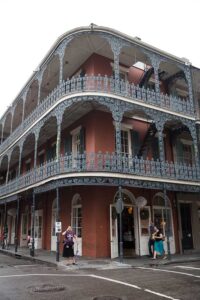 parade allowed to be motorized. The city takes prevention very seriously, knowing that fire spreading would be devastating to the French Quarter and to the city as a whole. Even with every precaution, the most important fires of the Twentieth Century occurred at individual structures. It is thought, by some historians, that the burning of the Old French Opera House on Bourbon, in 1919, was the “final nail” in the coffin of the old Creole culture in the Quarter, while others adopted that culture, thereby keeping its memory alive. Then, when the Cabildo burned in 1988, two hundred years after the First Great Fire, the citizens of the city felt the loss deeply. The structure was carefully restored, and it stands as a proud reminder of a city’s resolve to safeguard its heritage to this day.
parade allowed to be motorized. The city takes prevention very seriously, knowing that fire spreading would be devastating to the French Quarter and to the city as a whole. Even with every precaution, the most important fires of the Twentieth Century occurred at individual structures. It is thought, by some historians, that the burning of the Old French Opera House on Bourbon, in 1919, was the “final nail” in the coffin of the old Creole culture in the Quarter, while others adopted that culture, thereby keeping its memory alive. Then, when the Cabildo burned in 1988, two hundred years after the First Great Fire, the citizens of the city felt the loss deeply. The structure was carefully restored, and it stands as a proud reminder of a city’s resolve to safeguard its heritage to this day.
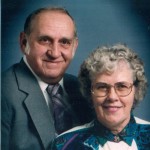 My Aunt Jeanette Byer has always been a sweet person, who was easy to get along with, and yet she was also a hard working, and really tough lady when she needed to be. For most of the years of my memory, she and my Uncle Larry lived on a piece of land east of Casper where they raised their two children, Larry and Tina. They really loved their place out in the country, but as life sometimes shows us, change happens. The job at the Texaco Refinery in Casper, Wyoming was closing, and Uncle Larry was offered a transfer to Louisiana. So they packed up their home and moved to the New Orleans area. They split up their property between their two kids, as settled down in their new home, and Uncle Larry to his new job. There were also trips here and there, seeing all the sights in their new home. Louisiana is, of course, a beautiful state.
My Aunt Jeanette Byer has always been a sweet person, who was easy to get along with, and yet she was also a hard working, and really tough lady when she needed to be. For most of the years of my memory, she and my Uncle Larry lived on a piece of land east of Casper where they raised their two children, Larry and Tina. They really loved their place out in the country, but as life sometimes shows us, change happens. The job at the Texaco Refinery in Casper, Wyoming was closing, and Uncle Larry was offered a transfer to Louisiana. So they packed up their home and moved to the New Orleans area. They split up their property between their two kids, as settled down in their new home, and Uncle Larry to his new job. There were also trips here and there, seeing all the sights in their new home. Louisiana is, of course, a beautiful state.

Louisiana was a big change for to small city people from the much colder state of Wyoming. One big change is the difference in the level of humidity, which is quite high in Louisiana. I’m sure it was a bit of a transition for them. I know that when my parents visited them there, my mom, Collene Spencer noticed a feeling of difficulty breathing. It wasn’t serious, just that the added humidity made the air feel heavy, and difficult to breathe in. Aunt Jeanette told her that is was something you get used to, and I’m sure it is, and the time spent there for a visit would not give you enough time to do so. Aunt Jeanette also told her that the humidity made you feel wet right after you dried off after showering. While the warmer weather would be nice, I don’t know if the humidity would be a good trade off to get it.
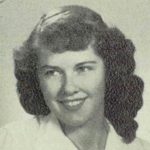 I think that Aunt Jeanette and Uncle Larry felt the same way, because when he retired, they headed back to good ole’ Wyoming. Of course, their children and grandchildren are still in the Casper, Wyoming area, so that gave an incentive to move back. We, the family, were all glad they were back too. Louisiana is really far from Wyoming, and we missed them. They moved their things back to Casper over two summers, and on the second trip, they stayed. Uncle Larry passed away, on December 22, 2011, but we still have Aunt Jeanette with us. She is in good health and doing well. I even came across her high school graduation picture as I was contemplating my story. Wasn’t she beautiful!! Today is Aunt Jeanette’s 84th birthday. Happy birthday Aunt Jeanette!! Have a great day!! We love you!!
I think that Aunt Jeanette and Uncle Larry felt the same way, because when he retired, they headed back to good ole’ Wyoming. Of course, their children and grandchildren are still in the Casper, Wyoming area, so that gave an incentive to move back. We, the family, were all glad they were back too. Louisiana is really far from Wyoming, and we missed them. They moved their things back to Casper over two summers, and on the second trip, they stayed. Uncle Larry passed away, on December 22, 2011, but we still have Aunt Jeanette with us. She is in good health and doing well. I even came across her high school graduation picture as I was contemplating my story. Wasn’t she beautiful!! Today is Aunt Jeanette’s 84th birthday. Happy birthday Aunt Jeanette!! Have a great day!! We love you!!
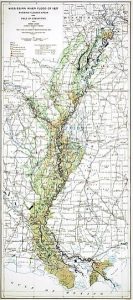 The Mississippi River is a is the widest river in the United States. It’s mere size and the amount of water in it, makes one expect that at some point, it is going to flood. In fact, it has flooded many times over the years, but none was anything like the Great Mississippi Flood of 1927. It was the most destructive river flood in the history of the United States. In all, 27,000 square miles of land were inundated with water up to a 30 feet depth. In all, 630,000 people were affected by the flood. About 94% of them lived in the states of Arkansas, Mississippi, and Louisiana, most in the Mississippi Delta. At least 15 inches of rain fell in 18 hours causing the Mississippi River to brake out of its levee system at 145 locations. Ten states were affected…Arkansas, Illinois, Kentucky, Louisiana, Mississippi, Missouri, Tennessee, Texas, Oklahoma, and Kansas. Arkansas was the worst affected with 14% of the state flooded.
The Mississippi River is a is the widest river in the United States. It’s mere size and the amount of water in it, makes one expect that at some point, it is going to flood. In fact, it has flooded many times over the years, but none was anything like the Great Mississippi Flood of 1927. It was the most destructive river flood in the history of the United States. In all, 27,000 square miles of land were inundated with water up to a 30 feet depth. In all, 630,000 people were affected by the flood. About 94% of them lived in the states of Arkansas, Mississippi, and Louisiana, most in the Mississippi Delta. At least 15 inches of rain fell in 18 hours causing the Mississippi River to brake out of its levee system at 145 locations. Ten states were affected…Arkansas, Illinois, Kentucky, Louisiana, Mississippi, Missouri, Tennessee, Texas, Oklahoma, and Kansas. Arkansas was the worst affected with 14% of the state flooded.
It was Good Friday, April 15, 1927, the disaster began when 15 inches of rain fell in New Orleans in 18 hours. More than 4 feet of water covered parts of the city. A group of influential bankers in town met to discuss how to guarantee the safety of the city, as they had already learned of the massive scale of flooding upriver. A few weeks after, they arranged to set off about 30 tons of dynamite on the levee at Caernarvon, in an effort to flood a less populated area and save the cities that would have been severely damaged. I’m not sure how much this effort helped, and in the end, about 500 people lost their lives anyway. It wouldn’t be the last Mississippi River flood, but it would be the worst.
As a result of the flooding, many of the misplaced people joined the Great Migration from the south to northern and midwestern industrial cities rather than return to rural agricultural labor. I would think that the idea of such a massive amount of cleanup would be more than many people could take. This massive population movement increased from World War II until 1970. Of course, this volume of population movement would not be good for the states who were losing people. To try to prevent future floods, the federal government built the world’s 
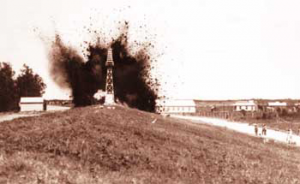 longest system of levees and floodways. By August 1927, when the flood subsided, hundreds of thousands of people had been made homeless and displaced; properties, livestock and crops were destroyed. Flooding on the Mississippi is not an unusual event, and no matter how many precautions we take, there will still be losses when the river overflows its banks.
longest system of levees and floodways. By August 1927, when the flood subsided, hundreds of thousands of people had been made homeless and displaced; properties, livestock and crops were destroyed. Flooding on the Mississippi is not an unusual event, and no matter how many precautions we take, there will still be losses when the river overflows its banks.
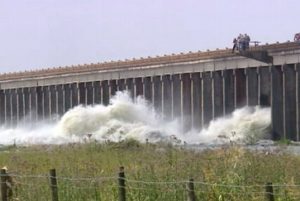
 As a kid, I remember that whenever we were sitting at an intersection that was very busy, causing us to have to wait seemingly forever to be able to get across the intersection, one of my parents would say something like, “Wow!! Who opened the floodgates?” Of course, I didn’t know what a floodgate was then, and I just thought they were referring to a flood of vehicles, which they were, and they probably didn’t think about what a real floodgate was either. It was just a funny saying to us, but in reality, a floodgate is a very important flood preventative tool. I guess that our version of floodgates meant the same thing, except in vehicles and not in water.
As a kid, I remember that whenever we were sitting at an intersection that was very busy, causing us to have to wait seemingly forever to be able to get across the intersection, one of my parents would say something like, “Wow!! Who opened the floodgates?” Of course, I didn’t know what a floodgate was then, and I just thought they were referring to a flood of vehicles, which they were, and they probably didn’t think about what a real floodgate was either. It was just a funny saying to us, but in reality, a floodgate is a very important flood preventative tool. I guess that our version of floodgates meant the same thing, except in vehicles and not in water.
On May 15, 2011, the United States Army Corps of Engineers opened the floodgates in the state of Louisiana along the Mississippi river. This was an effort to save larger cities located along the Mississippi, like Baton Rouge and New Orleans, from flooding. The Mississippi was already heading for critical stages, and it was only expected to get worse. The flooding was expected to cover up to three thousand square miles, and it had the potential to affect up to 25,000 people. This was the first time in forty years that the river levels have forced the opening of the floodgates. I don’t know how often floodgates are utilized in other areas to prevent flooding, but when people live in flood prone areas, they have to use whatever mean necessary to protect themselves and their property from damage and death.
The Mississippi River floods in April and May 2011 were among the largest and most damaging recorded along that river in the past century. The flood was comparable in extent to the major floods of 1927 and 1993. From April 14–16, the storm system that was responsible for one of the largest tornado outbreaks in US history also produced large amounts of rainfall across the southern and midwestern United States. Then two more storm systems, each with heavy rain and tornadoes, hit in the third week of April. In the fourth week of April, from April 25–28, another and even more extensive and deadly storm system passed through the Mississippi Valley dumping more rainfall resulting in deadly flash floods. The unprecedented extensive rainfall from these four storms, combined with springtime snow melt from the Upper Midwest, created the perfect conditions for a 500-year flood along the Mississippi.
The purpose of opening the floodgates was to take some of the pressure off of the levees, in the hope of preventing the breech of the levees. Most of the time, it works pretty well, like when the city of Casper, Wyoming, where I live opens up the gates at the area lakes and while the river runs high for a time, there are 
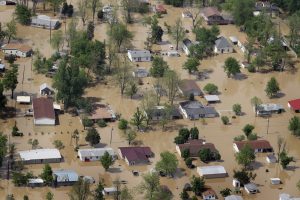 very few places where it spills over the bank. Unfortunately, the Mississippi river still spilled over its banks, and broke levees. I don’t think anyone could have really prevented the monster floods that hit the area in 2011, or even in 1927 or 1933, but they couldn’t focus on that right then, because they had to do whatever they could to prevent. In the end, the flood came and the damage was done.
very few places where it spills over the bank. Unfortunately, the Mississippi river still spilled over its banks, and broke levees. I don’t think anyone could have really prevented the monster floods that hit the area in 2011, or even in 1927 or 1933, but they couldn’t focus on that right then, because they had to do whatever they could to prevent. In the end, the flood came and the damage was done.

 My uncle, Larry Byer was the older of the three middle children of my grandparents, George and Hattie Byer, and a part of the three musketeers that included my mom, Collene Spencer and their brother, Wayne Byer. Uncle Larry was the older of the only two boys in the family, and with my mom in the middle, the three of them were into mischief a lot. While they were in trouble a lot, they were also best friends and allies. If one was in trouble the others tried to help…unless their mom was going to spank them, because they learned early on that you just didn’t mess with their mom.
My uncle, Larry Byer was the older of the three middle children of my grandparents, George and Hattie Byer, and a part of the three musketeers that included my mom, Collene Spencer and their brother, Wayne Byer. Uncle Larry was the older of the only two boys in the family, and with my mom in the middle, the three of them were into mischief a lot. While they were in trouble a lot, they were also best friends and allies. If one was in trouble the others tried to help…unless their mom was going to spank them, because they learned early on that you just didn’t mess with their mom.
Uncle Larry worked at the Texaco refinery for many years, and when they closed down, he was not at retirement age yet, so he took a transfer to New Orleans, Louisiana. He and Aunt Jeanette were gone for a number of years, and the whole family missed them, but several family members took the opportunity to visit them and had a great time in New Orleans. Uncle Larry and Aunt Jeanette treated each of their guests to the best the city had to offer. My parents took the opportunity to visit, and had a great time…once they got used to the heat. While they enjoyed every visit, I’m sure their favorite visitor, other than their children and grandchildren, was his mother. Grandma Byer went to visit, and they gave her the royal tour. The pictures of their visit were memories that Grandma would never forget. When the family went through Grandma’s things, they found he pictures of her visit among her things. They pictures were great, and you could tell that they both fully enjoyed the visit. It was one neither of them would ever forget.


Uncle Larry and Aunt Jeanette were still living in Louisiana when Grandma became ill, but she wanted to say goodbye to all of her children before she went home. She waited until Uncle Larry got home before she passed away. I know that Uncle Larry was always thankful that he made it home…and so was Grandma. Now both of them are together in Heaven, and I know that they are having a great time. Today is Uncle Larry’s birthday. He would have been 84 years old. Happy birthday in Heaven, Uncle Larry. We love and miss you very much.

 When you think of a town within a town or city, you often think of New York City, where you might find Queens, Harlem, or Yonkers. Or you might think of New Orleans, where you might find the French Quarter or the 9th Ward, but people really never think of a town within a town, when the town is a small town, like Forsyth, Montana, population of about 1,777. Nevertheless, Forsyth, Montana was a town that had within it a town…so to speak. When my husband, Bob Schulenberg’s grandpa, Andrew Schulenberg was a young married man, he built a couple of houses there. The houses were next door to each other. Andy’s parents lived in one house, and he and his wife, lived in the other. Across the street was another house owned by Schulenberg family relative, Bob’s Great Aunt Hennie. Being such a small town, there were other Schulenberg families very nearby, and since Andy’s parents, Max and Julia Schulenberg had ten children, it made for a lot of Schulenberg relation living in a neighborhood in Forsyth, Montana. Well, before long, the people of the town found themselves calling that neighborhood, Schulenbergville. I’m not sure just exactly when
When you think of a town within a town or city, you often think of New York City, where you might find Queens, Harlem, or Yonkers. Or you might think of New Orleans, where you might find the French Quarter or the 9th Ward, but people really never think of a town within a town, when the town is a small town, like Forsyth, Montana, population of about 1,777. Nevertheless, Forsyth, Montana was a town that had within it a town…so to speak. When my husband, Bob Schulenberg’s grandpa, Andrew Schulenberg was a young married man, he built a couple of houses there. The houses were next door to each other. Andy’s parents lived in one house, and he and his wife, lived in the other. Across the street was another house owned by Schulenberg family relative, Bob’s Great Aunt Hennie. Being such a small town, there were other Schulenberg families very nearby, and since Andy’s parents, Max and Julia Schulenberg had ten children, it made for a lot of Schulenberg relation living in a neighborhood in Forsyth, Montana. Well, before long, the people of the town found themselves calling that neighborhood, Schulenbergville. I’m not sure just exactly when 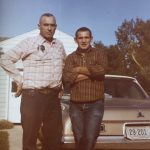 the neighborhood got its name, but since Andy was the sheriff of Rosebud County from 1955 to 1972, my guess is that it was either during that time, or it was his job as sheriff that solidified the name to that area of town.
the neighborhood got its name, but since Andy was the sheriff of Rosebud County from 1955 to 1972, my guess is that it was either during that time, or it was his job as sheriff that solidified the name to that area of town.
I had the chance to see the two houses that Andy Schulenberg built, and to find out that the second one was the house that Bob’s Uncle Butch Schulenberg was born in. I love to see the homes where loved ones were born, partly I suppose, because so few people are born at home these days. In those days, however, being born at home was a very common practice, and it makes me think about the history that the house has witnessed. The house got to see little Butch Schulenberg growing up…or at least starting his life, since I don’t know when the family might have moved out of the house. Nevertheless, the area remained Schulenbergville for a number of years, and I don’t think the locals have forgotten it to this day.
Nor have they forgotten the sheriff who really made the Schulenberg name a household word in the little town of Forsyth. Andy was a different kind of sheriff from those you normally meet, and that is a story I will tell sometime, but it’s too long for this story. Suffice it to say that he was dearly loved, and there is more than one 
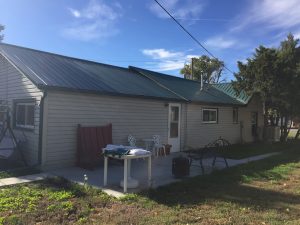 adult who owes the fact that they weren’t in prison…or worse as kids, to Sheriff Andy Schulenberg, and they will be happy to tell you so. The two houses Andy built still stand, as do the houses of the neighboring Schulenberg clan members, although some are no longer occupied. I find that a bit sad, but it is a testament to good construction work. Now they stand as a treasured memory for those who knew Schulenbergville well.
adult who owes the fact that they weren’t in prison…or worse as kids, to Sheriff Andy Schulenberg, and they will be happy to tell you so. The two houses Andy built still stand, as do the houses of the neighboring Schulenberg clan members, although some are no longer occupied. I find that a bit sad, but it is a testament to good construction work. Now they stand as a treasured memory for those who knew Schulenbergville well.

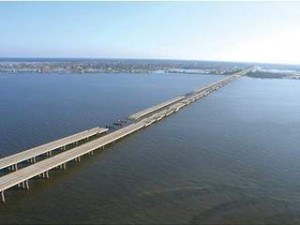 On August 29, 2005, Hurricane Katrina came screaming into southeast Louisiana. It quickly set its sights on a large lake that many people in the rest of the United States probably didn’t even know existed, and those who did know, gave little thought to it. Nevertheless, Lake Pontchartrain was about to make national headlines, where it would remain for months to come. Hurricane Katrina and Lake Pontchartrain were about to make history. Together they were set to cause the music in the party town of New Orleans to stop. And it would be a long time before the people of New Orleans would feel much like singing. Nevertheless, the city of New Orleans would return to its former self again.
On August 29, 2005, Hurricane Katrina came screaming into southeast Louisiana. It quickly set its sights on a large lake that many people in the rest of the United States probably didn’t even know existed, and those who did know, gave little thought to it. Nevertheless, Lake Pontchartrain was about to make national headlines, where it would remain for months to come. Hurricane Katrina and Lake Pontchartrain were about to make history. Together they were set to cause the music in the party town of New Orleans to stop. And it would be a long time before the people of New Orleans would feel much like singing. Nevertheless, the city of New Orleans would return to its former self again.
Bob and I were among those people who had really never heard of Lake Pontchartrain, and like us, if you didn’t know much about Lake Pontchartrain, you didn’t really understand the magnitude of the weakened levees. Hurricane Katrina brought heavy rain to Louisiana. Eight to ten inches fell on the eastern part of the state. In the area around Slidell even more rain fell. The highest rainfall recorded in the state was 15 inches. As a result of the rainfall and storm surge the level of Lake Pontchartrain rose and caused significant flooding along its northeastern shore, affecting communities from Slidell to Mandeville. Several bridges were damaged or destroyed, including the I-10 Twin Span Bridge connecting Slidell to New Orleans. Almost 900,000 people in Louisiana lost power as a result of Hurricane Katrina. In the end, at least 1,245 people died in the hurricane and subsequent floods, making it the deadliest United States hurricane since the 1928 Okeechobee hurricane.
Bob and I traveled to New Orleans in April of 2012. So many changes took place between August of 2005 and April of 2012. Nevertheless, I wasn’t sure how I felt about driving across that causeway that spanned Lake Pontchartrain. Yes, it had escaped damage in Hurricane Katrina, but it still crossed the widest part of a very large lake, and since I knew that the lake’s surges had the ability to severely damage it and the surrounding area…well, I just didn’t know how I would feel about the 23.83 mile drive across…not until we started across the bridge that is. It was an amazing bridge, and an amazing ride across it. The lake was serene, and I found myself hard pressed to picture the lake surging in the fury of a hurricane. I found it hard to picture the water so wild that it could damage a bridge, but it had happened…not to this bridge, but to others. The causeway bridge had been in use from it’s opening on August 30, 1956. At the time we were there, I had no idea of the length of the history of the Causeway. The idea of a bridge spanning Lake Pontchartrain dates back to the early 19th century and Bernard de Marigny, the founder of Mandeville. He started a ferry service that continued to operate into the mid-1930s.
After the 30s, and prior to the Causeway being built, people who lived in Covington and worked in New Orleans, had a very long commute to work. The bridge, while still 23.83 miles across the lake, took a large portion of that commute away. It was truly a great asset to the cities on both sides of the lake. Since 1969, the Causeway was listed by Guinness World Records as the longest bridge over water in the world. In 2011, when 
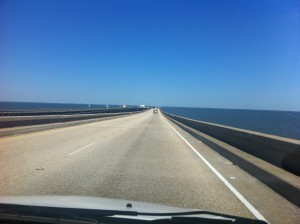 the allegedly longer Jiaozhou Bay Bridge in China was built, Guinness created two categories for bridges over water…continuous and aggregate lengths over water. Lake Pontchartrain Causeway became the longest bridge over water (continuous), while Jiaozhou Bay Bridge the longest bridge over water (aggregate)…because of its sections that are over land. Even if the bridge does get replaced as the longest bridge, it will nevertheless, remain a very long bridge. And the drive over the bridge was as awe inspiring as it could be.
the allegedly longer Jiaozhou Bay Bridge in China was built, Guinness created two categories for bridges over water…continuous and aggregate lengths over water. Lake Pontchartrain Causeway became the longest bridge over water (continuous), while Jiaozhou Bay Bridge the longest bridge over water (aggregate)…because of its sections that are over land. Even if the bridge does get replaced as the longest bridge, it will nevertheless, remain a very long bridge. And the drive over the bridge was as awe inspiring as it could be.
 When my Uncle Larry and Aunt Jeanette Byer moved to New Orleans, Louisiana after taking a job transfer, I have to imagine that it was pretty hard on my grandmother, Hattie Byer, Uncle Larry’s mom. Grandma, like most mothers, liked having her children close, and to have one move almost 1600 miles away, has a bit of a sting to it. I can relate to how Grandma must have felt, since I now have a daughter who lives 1200 miles away. I always knew I wouldn’t love having my kids leave, but you can’t really grasp just how it feels until it happens to you. Nevertheless, people have told me that you get used to it, that you have a new place to vacation, and that you simply make arrangements to see them. I’ve also been told that they try to come home as often as they can, and you hope that is the way it works out, but you
When my Uncle Larry and Aunt Jeanette Byer moved to New Orleans, Louisiana after taking a job transfer, I have to imagine that it was pretty hard on my grandmother, Hattie Byer, Uncle Larry’s mom. Grandma, like most mothers, liked having her children close, and to have one move almost 1600 miles away, has a bit of a sting to it. I can relate to how Grandma must have felt, since I now have a daughter who lives 1200 miles away. I always knew I wouldn’t love having my kids leave, but you can’t really grasp just how it feels until it happens to you. Nevertheless, people have told me that you get used to it, that you have a new place to vacation, and that you simply make arrangements to see them. I’ve also been told that they try to come home as often as they can, and you hope that is the way it works out, but you 
never know, until you see for yourself, if it all really works out that exact way.
This was where Grandma Byer found herself when Uncle Larry and Aunt Jeanette moved to New Orleans for several years before his eventual retirement from Texaco. Everyone could see that this was the best move to make, but that didn’t make it easier. For Grandma, the move broadened her horizons, as it turned out. Grandma did go to see Uncle Larry and Aunt Jeanette, just as she had come to see our family when we lived in Superior, Wisconsin. In some ways, I have to wonder if…somewhere in the back of her mind, she liked having someone in her family living in Louisiana…because it would mean that she could go there for visits, and have someone who could really show her the sights, instead of trying to figure out what was good to see, and what wasn’t or what was boring. New Orleans is such a big place, with so much to see, and if you don’t know where all the cool sights are, you will miss something. I think that for Grandma, there would also be the being alone factor, that would not be very appealing, so going to visit her son and his wife, and see the  sights must have been a great thrill for her.
sights must have been a great thrill for her.
Grandma never liked going to bed until all her kids were home, so having one of them so far away had to have been very hard. I’m certain it was hard on Uncle Larry and Aunt Jeanette too, because they had to leave their children and their family behind as well. Nevertheless, it was just for a short time and then they returned to Casper. We were all glad to have them back here. Sadly, Uncle Larry passed away on December 22, 2011. We will always miss he jokes, his smile, and his wonderful laugh. Today would have been Uncle Larry’s 81st birthday. Happy birthday in Heaven Uncle Larry. We love and miss you very much.
 Marrying someone that you grew up with is not something most of us really expect to do, but that is what my Aunt Jeanette did, when she married my mom’s brother, my Uncle Larry. Mom said it was strange to have someone that had been an acquaintance suddenly become her sister-in-law…especially a high school acquaintance, because we just never really think those people will be in our lives much after graduation. Nevertheless, it does and did happen.
Marrying someone that you grew up with is not something most of us really expect to do, but that is what my Aunt Jeanette did, when she married my mom’s brother, my Uncle Larry. Mom said it was strange to have someone that had been an acquaintance suddenly become her sister-in-law…especially a high school acquaintance, because we just never really think those people will be in our lives much after graduation. Nevertheless, it does and did happen.
Over the years, Aunt Jeanette has become such a special part of this family. I love her laugh, and her special way with people. Until more recently though, I didn’t realize that she also shares her birthday with my husband, Bob. As our family grows and grows, that is becoming increasingly more common.
Aunt Jeanette joined our family as it hit a pretty major growth spurt. There were five or six of the kids who were having children at the same time. I was born into that bunch, having three male cousins born in close proximity to my birthday…Elmer was born in March of 1956, I was born in April of 1956, Forrest was born in July of 1956, and Larry was born in February of 1957. I’m not sure how I managed not to be a serious tomboy being surrounded by all of those boys, but somehow I really wasn’t so much.
When the Texaco Refinery closed and Uncle Larry decided to take the transfer to New Orleans, Louisiana, we were all very sad to see them go. It had been a number of years since any of Grandma and Grandpa’s kids had lived outside Wyoming, and it just seem like it was going to 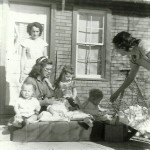 be forever, even though they assured us that it was just until his retirement. I just remember thinking that it was really sad, because they would be gone a long time. I’m many ways it was good for Grandma and for my family, because both went down to Louisiana to visit them, and had a very nice time.
be forever, even though they assured us that it was just until his retirement. I just remember thinking that it was really sad, because they would be gone a long time. I’m many ways it was good for Grandma and for my family, because both went down to Louisiana to visit them, and had a very nice time.
Finally they returned to Wyoming for good, and Bob and I loved running into them every once in a while. It always seemed to be in someplace like Home Depot or Menard’s or something like that, but that’s ok too. When you have a big family, that is sometimes the best way to see each other. Today is Aunt Jeanette’s 78th birthday. Happy birthday Aunt Jeanette!! Have a great day!! We love you!!

